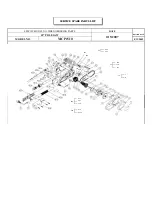
ENGLISH
33
6. Tighten the blade clamping screw firmly using
the wrench.
Adjusting the Riving Knife (fi g. 5)
For the correct adjustment of the riving knife (g),
refer to the inset in figure 5. Adjust the clearance
of the riving knife after changing the saw blade or
whenever necessary.
1. Adjust the depth of cut to 0 mm to access both
clamping screws (u) of the riving knife.
2. Loosen the screws (u) and pull out the riving
knife to its maximum length.
3. Adjust the clearance and tighten the screw.
Adjusting the Cutting Line Marks
(fi g. 6)
The marks for bevel cuts (l) and for straight cuts (m)
have two grooves each:
– narrow groove: for centring standard steel
blades
– wider groove: for centring TCT blades
To adjust, proceed as follows:
1. With the blade locked at 90°, make a trial cut
of approx. 400 mm.
2. Withdraw the saw slightly.
3. Slacken the screw (v) and align the cut (w) and
the mark (m).
4. Firmly tighten the screw (v).
Both cutting line marks are now correctly adjusted.
Mounting and Adjusting the Parallel
Fence (fi g. 7)
The parallel fence (o) is used for cutting parallel to
the edge of the workpiece.
Mounting
1. Insert the parallel fence (o) in the saw shoe (f) as
shown.
2. Insert the bolt (x) into the hole (y).
3. Place the clamping bracket (z) over the bolt and
tighten the locking screw (aa).
Adjusting
1. Slacken the locking screw (aa) and set the
parallel fence (o) to the desired width. The
adjustment can be read on the scale (bb).
2. Tighten the locking screw (aa). The marks (cc)
and (dd) can be used as a guide: mark (cc): for
standard steel blades mark (dd): for TCT blades.
Prior to Operation
•
Make sure the guards have been mounted
correctly. The saw blade guard must be in
closed position.
•
Make sure the saw blade rotates in the direction
of the arrow on the blade.
OPERATION
Instructions for Use
WARNING:
Always observe the safety
instructions and applicable regulations.
WARNING: To reduce the risk
of serious personal injury, turn
tool off and disconnect tool from
power source before making any
adjustments or removing/installing
attachments or accessories.
WARNING:
•
Ensure the material to be sawn is
firmly secured in place.
•
Apply only a gentle pressure to the
tool and do not exert side pressure on
the saw blade.
• Avoid overloading.
•
Do not use excessively worn saw
blades. Do not use your saw for
pocket cuts.
Proper Hand Position (fi g. 8)
WARNING:
To reduce the risk of
serious personal injury,
ALWAYS
use
proper hand position as shown.
WARNING:
To reduce the risk of
serious personal injury,
ALWAYS
hold
securely in anticipation of a sudden
reaction.
Hold the tool by the main handle (ee) and the front
handle (c) to guide the saw properly.
Switching On and Off (fi g. 1)
For safety reasons the on/off switch (a) of your tool is
equipped with a lock-off button (b). Press the lock-
off button to unlock the tool. To run the tool, press
the on/off switch (a). As soon as the on/off switch is
released the lock-off switch is automatically activated
to prevent unintended starting of the machine.
Содержание D23700
Страница 1: ...www eu D23700 ...
Страница 3: ...1 Figure 1 a b d e f c ff g h i j k k n o l m ee ...
Страница 4: ...2 k h k f Figure 2 Figure 3 ...
Страница 5: ...3 u j s r t g i h d 5 mm k q p Figure 4 Figure 5 ...
Страница 6: ...4 l w m v o bb y z aa f x dd cc Figure 6 Figure 7 ...
Страница 7: ...5 Figure 8 ee c ...
















































